1. Project Introduction
1.1 Background analysis
A company's auditing system is the most basic issue of a company that cannot be ignored. Whether the audit supervision business is timely and accurate, and whether the audit management is effective depends to a large extent on whether the audit decision-making is feasible. To meet this requirement, it must be based on a large amount of internal and external information of the audit organization. In addition, due to the similarity and correlation of decision-making among various functional departments, the same information is collected and provided most repeatedly. In order to make audit information suitable for different levels of decision-making, coordinate audit information activities of various functional departments, reduce repetitive business, and improve information work efficiency, it is also necessary to establish an audit information management system. Especially for large companies, a good audit system can make the company solve problems faster and more efficiently.
Audit information management system (Management System Of Audit Information) refers to the use of an organized system to collect, process, transmit, and provide information to organizations and other relevant parties for the audit information required for audit supervision and management. system. The form of audit information management system is audit information network system.
This article is based on my own experience as a part-time job in Postal Savings Bank as an example, combined with the analysis of the needs of the audit process, using Java as the back-end development language, using html5+css3+jquery in the front-end, using MySQL as the relational database platform, and designing The Web side of the audit system has been opened. The system realizes basic employee registration and login, basic information management, project information management, meeting information management and other functions.
This article analyzes the possible requirements of the company's audit system, focusing on the analysis of the system's employee information management, background management functions, and required databases, and gives the implementation method of the main functions of the system, showing the final implementation effect and testing result.
1.2. Purpose
The sharp increase in the amount of information is one of the characteristics of today's world. Just looking at the amount of knowledge that humans possess, it has quadrupled from the beginning of AD to the 1960s, and the speed is getting faster and faster, just as the British scientist James Martin speculated Similarly, human scientific knowledge doubled in 50 years in the 19th century. In the middle of the 20th century, it doubled every ten years, and in the 1970s it doubled every five years. Some scientists estimate that it doubles every 3 years. Audit information is no exception, not only because of the rapid growth of the audit environment and information on the economic activities of the audited unit, but also the business volume of collecting, processing, outputting, feeding back and storing audit information. In addition, the sources and contents of audit information are becoming more and more complex, which makes the collection, processing, output, feedback and storage of audit information more and more complicated. For this reason, it is increasingly necessary to establish a system dedicated to audit information management. Otherwise, it is difficult to get timely and correct processing of such voluminous and complicated curtain meter information.
In this case, the establishment of the audit information management system gradually strengthens the concentration, unity and professionalism of the audit information management system, paving the way for the modernization of audit information management. The Postal Savings Bank audit system I designed can initially solve these problems.
The work done in the thesis has certain social significance and can solve practical problems.
2. System technical overview
2.1 Overview of system front-end technology
2.1.1 HTML5
HTML5 is a language description for building web content. HTML5 is the next-generation standard of the Internet and a language way to construct and present Internet content. It is considered to be one of the core technologies of the Internet. HTML was produced in 1990, and HTML4 became an Internet standard in 1997, and is widely used in the development of Internet applications.
Next-generation web standards enable programs to pass through a web browser, allowing consumers to access the same programs and cloud-based information from any terminal, including a PC, laptop, smartphone or tablet.
HTML5 allows programs to run through a web browser, and incorporates multimedia content such as videos that currently require plug-ins and other platforms to be used. This will make the browser a universal platform, and users can complete tasks through the browser. Due to the relatively advanced local storage technology in the HTML5 technology, it can reduce the response time of the application program and bring a more convenient experience to the user.
2.1.2 CSS3
CSS3 is an upgraded version of (cascading style sheet) technology, which was developed in 1999. On May 23, 2001, W3C completed the working draft of CSS3, mainly including box model, list module, method, language module, background and border, text Special effects, multi-column layout and other modules.
CSS3 programming tools are the same as CSS, and any kind of text editing tool can be used for writing, such as: writing pad, notepad under Windows; or other tools specially used for editing web page text.
The syntax of CSS3 is based on the original version of CSS, which allows users to specify specific HTML elements in tags without using redundant classes, IDs, or JavaScript. Most of CSS selectors are not new in CSS3, but have not been widely used in previous versions. If you want to try to achieve a clean, lightweight label and a better separation of structure and performance, advanced selectors are very useful, they can reduce the number of classes and IDs in the label and make it easier for designers to maintain style sheet.
2.1.3 Jquery and Ajax
Jquery is a fast, concise JavaScript framework that advocates writing less code and doing more. It encapsulates the functional codes commonly used in JavaScript, provides a simple JavaScript design pattern, and optimizes HTML document operations, event handling, animation design and Ajax interaction.
The core features of Jquery can be summarized as follows: it has a unique chain syntax and a short and clear multi-functional interface; it has efficient and flexible CSS selectors and can extend CSS selectors; it has a convenient plug-in extension mechanism and rich plug-ins. Generally speaking, Jquery is chosen because of its following characteristics:
More convenient selector Jquery's selection mechanism is built on the CSS selector, which provides the ability to quickly query elements in the DOM document, and greatly strengthens the way to obtain page elements in JavaScript. Compared with the original selector, Jquery uses fewer statements to achieve the same effect, and the selection accuracy is also higher.
-
Provide page dynamic effects Jquery has a series of built-in animation effects, such as fade in and fade out, element removal and other dynamic effects. These special effects enhance the user's experience when browsing the web, and are used by many websites.
-
Create Ajax non-refresh web pages Ajax is the abbreviation of asynchronous JavaScript and XML, which can help develop very responsive and non-refresh web pages
-
Enhancements to the JavaScript language Jquery provides enhancements to basic JavaScript structures, such as element iteration and array processing.
-
Enhanced event handling Jquery provides various page events, which can avoid programmers adding too much event handling code in HTML, and its event handler eliminates various browser compatibility issues.
Ajax is the abbreviation of a part of the Jquery framework. It is widely used in web page production. Its specific functions are also mentioned in the characteristics of Jquery described above. The processing in the background produces the response.
Without the help of Ajax, we must perform multiple jumps from the current page to the control view layer and then back to the current page when we operate the page logic, which greatly affects the user's operating experience. With the help of Ajax, the user can continue to browse the front-end page when the back-end is processing the request, until the response returns to the front-end user to operate, the whole process is more coherent, and the user's operating experience will naturally be better.
2.2 Overview of system back-end technology
2.2.1 MySQL database
Databases are divided into relational databases and non-relational databases. A relational database refers to a database that uses a relational model to organize data, and has concepts such as relations, tuples, attributes, domains, keywords, and relational schemas. Relational databases are more intuitive, easier to understand, more convenient to use, and easier to maintain. However, the performance of relational databases is poor, and the efficiency is very low when dealing with a large amount of data with complex relationships. Our commonly used relational databases include Oracle, Microsoft SQL Server, MySQL, PostgreSQL, DB2, Microsoft Access, SQLite, etc.
Non-relational databases refer to non-relational, distributed databases as opposed to relational databases. It is stored in key-value pairs, and the structure is not fixed. Each tuple can have different fields, and each tuple can add some key-value pairs as needed, not limited to a fixed structure. The non-relational database has a simple structure, which can save a little time and overhead when processing data. However, it is limited to some simple databases without complex relationships, and is not suitable for persistent storage of massive data. Since non-relational databases appear for certain specific application requirements, different non-relational databases have different strengths and are mainly divided into the following categories: key-value databases for high-performance concurrent read and write, mainstream representatives Redis, Amazon DynamoDB; document-oriented databases for massive data access, the mainstream representatives are MongoDB; search engines for searching data content, mainstream representatives are Splunk and Solr; distributed databases for scalability, mainstream representatives are Cassandra, Hbase .
MySQL is a typical relational database. It was developed by the Swedish MySQL AB company and belongs to Oracle's products after being acquired. Like other relational databases, MySQL keeps data in separate tables, ensuring efficiency and increasing flexibility. MySQL is written in C and C++ and tested with a variety of compilers to ensure the portability of the source code, enabling it to support most operating systems.
The operating language used by MySQL is the SQL language, the most commonly used standardized language for accessing databases. Due to its small size, fast speed, low total cost of ownership, and especially the open source feature, MySQL is generally chosen as the website database for the development of small and medium-sized websites. Although MySQL is not enough compared with other large databases, for individual developers, MySQL database contains all the functions required for personal development, and it is free and open, which reduces the learning cost. It is also for the above reasons that I chose the MySQL database as the project database in the housing rental system.
2.2.2 Tomcat server
To build a web project, a server is essential. Tomcat is the first choice for personal JavaWeb development because of its advanced technology, stable performance, and free of charge.
Tomcat server is a free and open source web application server, jointly developed by Apache, Sun and some other companies and individuals, it is a lightweight application server. It is more commonly used in small and medium-sized systems and occasions where there are not many concurrent access users, and is the first choice for developing and debugging JSP programs. After Tomcat is configured, developers can run JSP pages and Servlets on the server. It has the function of processing HTML page requests, and it is also a Servlet and JSP container.
The version I built in the project is Tomcat 7.0, which can be used more conveniently after some simple configurations and Java development software such as Idea and Eclipse for personal use.
3. System design
3.1 Database design
After determining the design of the database, you can actually start creating the database. There are two ways to create a database, one is to directly call the console to input sql statements to create a database without using a database tool, and the other is to create a database using a visual page with the help of a database tool. Here, the Navicat database tool is used for subsequent convenient operation.

3.2 Functional Design
-
There are only three levels of staff and so on. The data shown above is just for testing. The three levels can be seen on the registration page
-
Login using ajax verification, registered user name ranking is also using ajax
-
For employee management, users can only modify their own passwords, and any auditor can delete other personnel. There is no permission setting here.
-
The admin user cannot declare projects because he is the default meeting leader. No authority to do audit projects, only the right to approve the batch documents
Open the project section. In the opening project section, the admin can modify unapproved declared projects. For other members, if the project fails to pass the review, the project will never be reported again. I had to re-declare another project. After all, the relationship between projects and auditors is many-to-one, not many-to-many.
All deletions in this system are based on the corresponding Id number to delete the item.
For the program management part, if the audit is not passed, the on-site audit cannot be performed.
4. System Implementation
4.1 Database Implementation

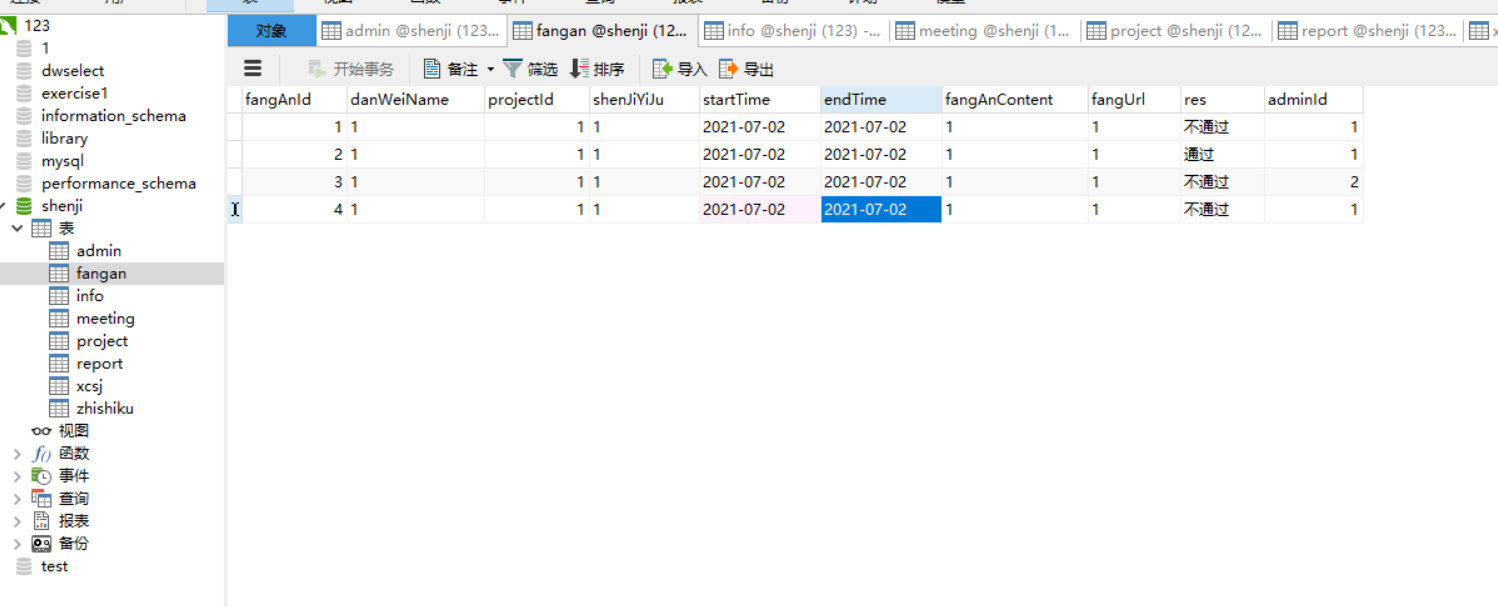


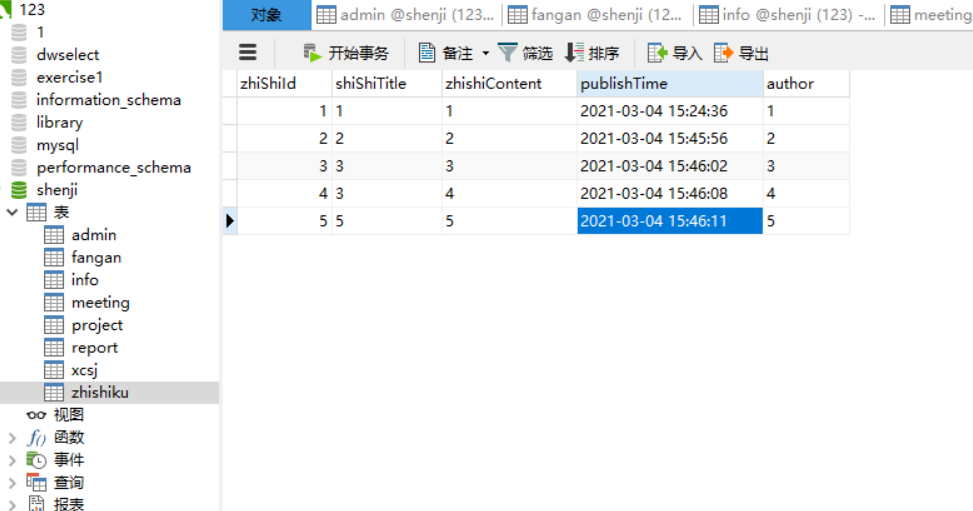
4.2 Function realization


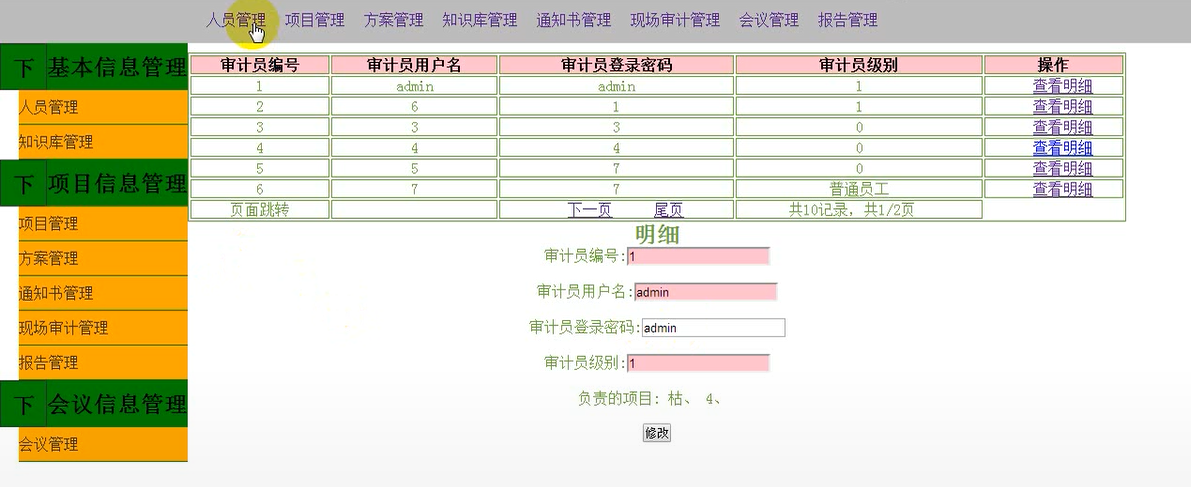

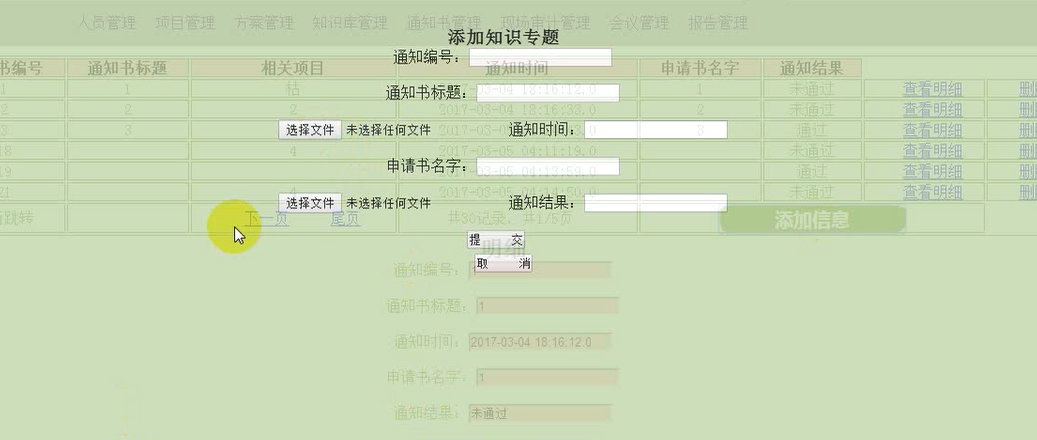
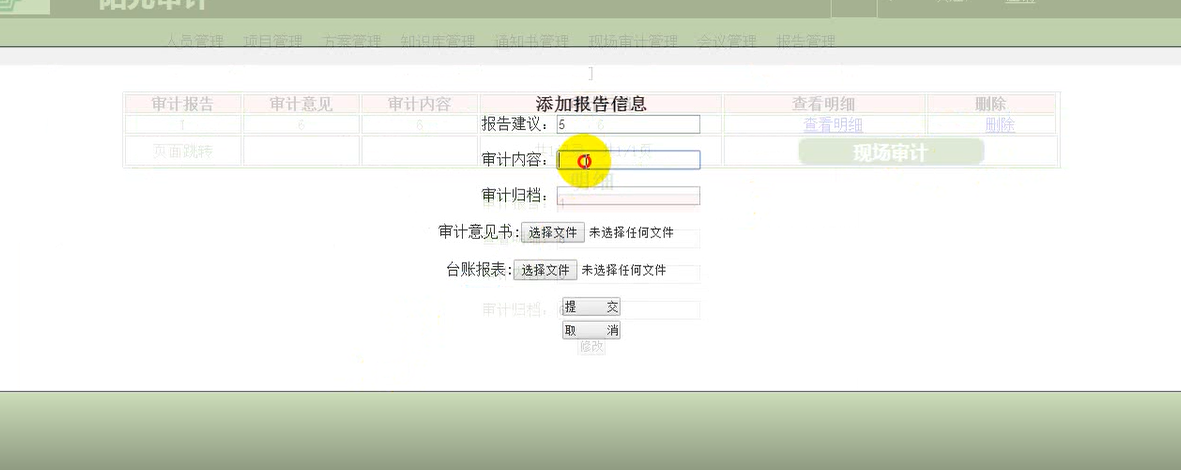
♻️ Resources
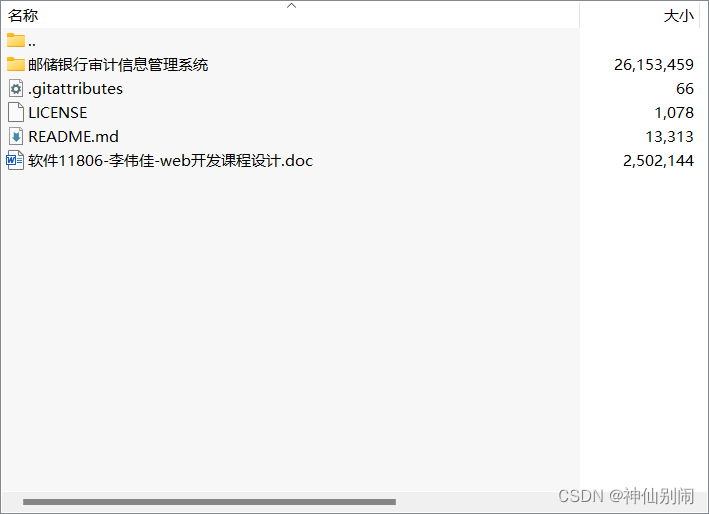
Size: 24.9MB
➡️ Resource download: https://download.csdn.net/download/s1t16/87553492
Note: If the current article or code violates your rights, please private message the author to delete it!